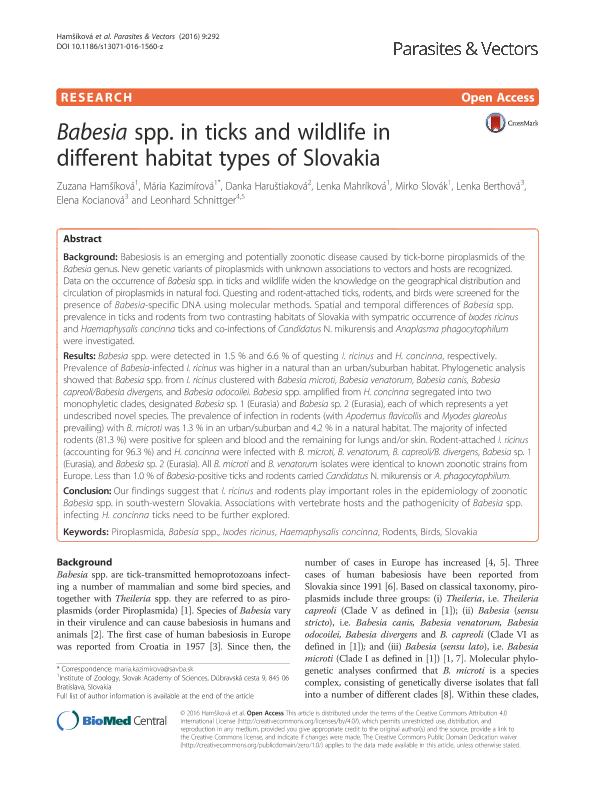Mostrar el registro sencillo del ítem
dc.contributor.author
Hamsíková, Zuzana
dc.contributor.author
Kazimírová, Mária
dc.contributor.author
Harustiaková, Danka
dc.contributor.author
Mahríková, Lenka
dc.contributor.author
Slovák, Mirko
dc.contributor.author
Berthová, Lenka
dc.contributor.author
Kocianová, Elena
dc.contributor.author
Schnittger, Leonhard

dc.date.available
2018-04-04T14:58:34Z
dc.date.issued
2016-05
dc.identifier.citation
Hamsíková, Zuzana; Kazimírová, Mária; Harustiaková, Danka; Mahríková, Lenka; Slovák, Mirko; et al.; Babesia spp. in ticks and wildlife in different habitat types of Slovakia; BioMed Central; Parasites and Vectors; 9; 1; 5-2016
dc.identifier.issn
1756-3305
dc.identifier.uri
http://hdl.handle.net/11336/40673
dc.description.abstract
Background: Babesiosis is an emerging and potentially zoonotic disease caused by tick-borne piroplasmids of the Babesia genus. New genetic variants of piroplasmids with unknown associations to vectors and hosts are recognized. Data on the occurrence of Babesia spp. in ticks and wildlife widen the knowledge on the geographical distribution and circulation of piroplasmids in natural foci. Questing and rodent-attached ticks, rodents, and birds were screened for the presence of Babesia-specific DNA using molecular methods. Spatial and temporal differences of Babesia spp. prevalence in ticks and rodents from two contrasting habitats of Slovakia with sympatric occurrence of Ixodes ricinus and Haemaphysalis concinna ticks and co-infections of Candidatus N. mikurensis and Anaplasma phagocytophilum were investigated. Results: Babesia spp. were detected in 1.5 % and 6.6 % of questing I. ricinus and H. concinna, respectively. Prevalence of Babesia-infected I. ricinus was higher in a natural than an urban/suburban habitat. Phylogenetic analysis showed that Babesia spp. from I. ricinus clustered with Babesia microti, Babesia venatorum, Babesia canis, Babesia capreoli/Babesia divergens, and Babesia odocoilei. Babesia spp. amplified from H. concinna segregated into two monophyletic clades, designated Babesia sp. 1 (Eurasia) and Babesia sp. 2 (Eurasia), each of which represents a yet undescribed novel species. The prevalence of infection in rodents (with Apodemus flavicollis and Myodes glareolus prevailing) with B. microti was 1.3 % in an urban/suburban and 4.2 % in a natural habitat. The majority of infected rodents (81.3 %) were positive for spleen and blood and the remaining for lungs and/or skin. Rodent-attached I. ricinus (accounting for 96.3 %) and H. concinna were infected with B. microti, B. venatorum, B. capreoli/B. divergens, Babesia sp. 1 (Eurasia), and Babesia sp. 2 (Eurasia). All B. microti and B. venatorum isolates were identical to known zoonotic strains from Europe. Less than 1.0 % of Babesia-positive ticks and rodents carried Candidatus N. mikurensis or A. phagocytophilum. Conclusion: Our findings suggest that I. ricinus and rodents play important roles in the epidemiology of zoonotic Babesia spp. in south-western Slovakia. Associations with vertebrate hosts and the pathogenicity of Babesia spp. infecting H. concinna ticks need to be further explored.
dc.format
application/pdf
dc.language.iso
eng
dc.publisher
BioMed Central

dc.rights
info:eu-repo/semantics/openAccess
dc.rights.uri
https://creativecommons.org/licenses/by-nc-sa/2.5/ar/
dc.subject
Babesia Spp.
dc.subject
Birds
dc.subject
Haemaphysalis Concinna
dc.subject
Ixodes Ricinus
dc.subject
Piroplasmida
dc.subject
Rodents
dc.subject
Slovakia
dc.subject.classification
Otras Ciencias Biológicas

dc.subject.classification
Ciencias Biológicas

dc.subject.classification
CIENCIAS NATURALES Y EXACTAS

dc.title
Babesia spp. in ticks and wildlife in different habitat types of Slovakia
dc.type
info:eu-repo/semantics/article
dc.type
info:ar-repo/semantics/artículo
dc.type
info:eu-repo/semantics/publishedVersion
dc.date.updated
2018-04-03T18:44:41Z
dc.journal.volume
9
dc.journal.number
1
dc.journal.pais
Reino Unido

dc.journal.ciudad
Londres
dc.description.fil
Fil: Hamsíková, Zuzana. Slovak Academy of Sciences; Eslovaquia
dc.description.fil
Fil: Kazimírová, Mária. Slovak Academy of Sciences; Eslovaquia
dc.description.fil
Fil: Harustiaková, Danka. Masaryk University; República Checa
dc.description.fil
Fil: Mahríková, Lenka. Slovak Academy of Sciences; Eslovaquia
dc.description.fil
Fil: Slovák, Mirko. Slovak Academy of Sciences; Eslovaquia
dc.description.fil
Fil: Berthová, Lenka. Slovak Academy of Sciences; Eslovaquia
dc.description.fil
Fil: Kocianová, Elena. Slovak Academy of Sciences; Eslovaquia
dc.description.fil
Fil: Schnittger, Leonhard. Consejo Nacional de Investigaciones Científicas y Técnicas; Argentina. Instituto Nacional de Tecnología Agropecuaria. Centro de Investigación en Ciencias Veterinarias y Agronómicas; Argentina
dc.journal.title
Parasites and Vectors

dc.relation.alternativeid
info:eu-repo/semantics/altIdentifier/doi/http://dx.doi.org/10.1186/s13071-016-1560-z
dc.relation.alternativeid
info:eu-repo/semantics/altIdentifier/url/https://parasitesandvectors.biomedcentral.com/articles/10.1186/s13071-016-1560-z
Archivos asociados
